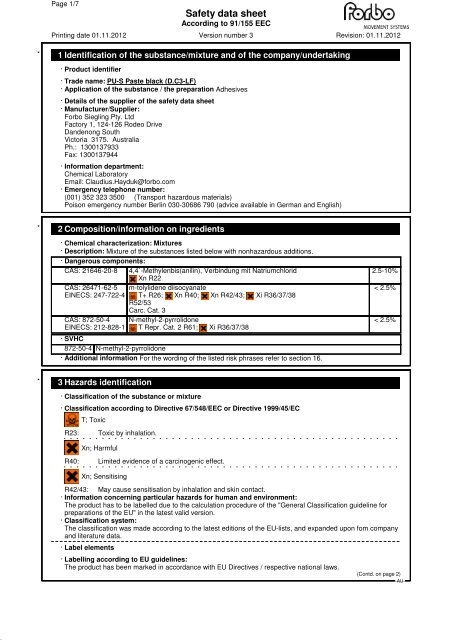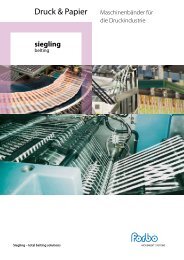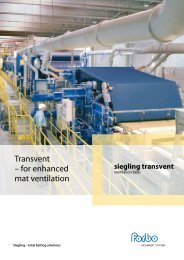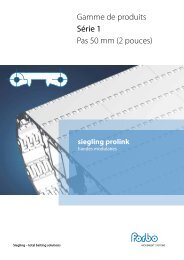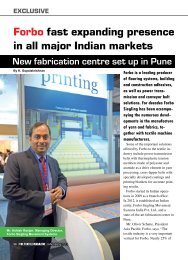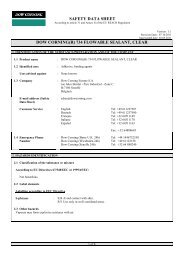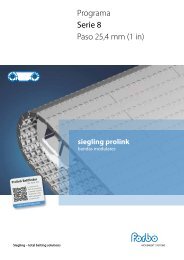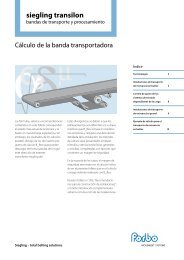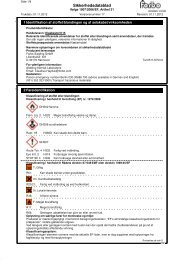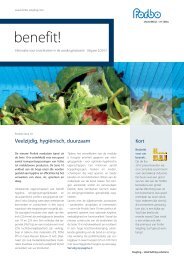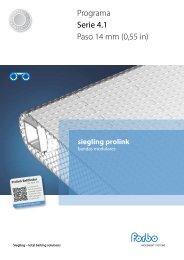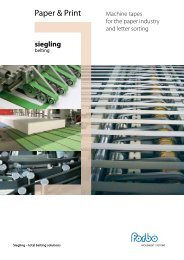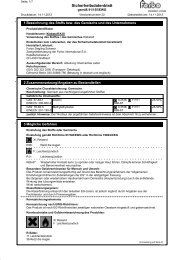PU-S Paste black (D.C3-LF) - Forbo Siegling
PU-S Paste black (D.C3-LF) - Forbo Siegling
PU-S Paste black (D.C3-LF) - Forbo Siegling
Create successful ePaper yourself
Turn your PDF publications into a flip-book with our unique Google optimized e-Paper software.
35.0.12<br />
Page 1/7<br />
Safety data sheet<br />
According to 91/155 EEC<br />
Printing date 01.11.2012 Version number 3<br />
Revision: 01.11.2012<br />
* 1 Identification of the substance/mixture and of the company/undertaking<br />
· Product identifier<br />
· Trade name: <strong>PU</strong>-S <strong>Paste</strong> <strong>black</strong> (D.<strong>C3</strong>-<strong>LF</strong>)<br />
· Application of the substance / the preparation Adhesives<br />
· Details of the supplier of the safety data sheet<br />
· Manufacturer/Supplier:<br />
<strong>Forbo</strong> <strong>Siegling</strong> Pty. Ltd<br />
Factory 1, 124-126 Rodeo Drive<br />
Dandenong South<br />
Victoria 3175. Australia<br />
Ph.: 1300137933<br />
Fax: 1300137944<br />
· Information department:<br />
Chemical Laboratory<br />
Email: Claudius.Hayduk@forbo.com<br />
· Emergency telephone number:<br />
(001) 352 323 3500 (Transport hazardous materials)<br />
Poison emergency number Berlin 030-30686 790 (advice available in German and English)<br />
* 2 Composition/information on ingredients<br />
· Chemical characterization: Mixtures<br />
· Description: Mixture of the substances listed below with nonhazardous additions.<br />
· Dangerous components:<br />
CAS: 21646-20-8 4,4`-Methylenbis(anilin), Verbindung mit Natriumchlorid<br />
Xn R22<br />
CAS: 26471-62-5<br />
EINECS: 247-722-4<br />
CAS: 872-50-4<br />
EINECS: 212-828-1<br />
m-tolylidene diisocyanate<br />
T+ R26; Xn R40; Xn R42/43; Xi R36/37/38<br />
R52/53<br />
Carc. Cat. 3<br />
N-methyl-2-pyrrolidone<br />
T Repr. Cat. 2 R61; Xi R36/37/38<br />
· SVHC<br />
872-50-4 N-methyl-2-pyrrolidone<br />
· Additional information For the wording of the listed risk phrases refer to section 16.<br />
* 3 Hazards identification<br />
· Classification of the substance or mixture<br />
· Classification according to Directive 67/548/EEC or Directive 1999/45/EC<br />
T; Toxic<br />
R23: Toxic by inhalation.<br />
Xn; Harmful<br />
R40: Limited evidence of a carcinogenic effect.<br />
Xn; Sensitising<br />
2.5-10%<br />
< 2.5%<br />
< 2.5%<br />
R42/43: May cause sensitisation by inhalation and skin contact.<br />
· Information concerning particular hazards for human and environment:<br />
The product has to be labelled due to the calculation procedure of the "General Classification guideline for<br />
preparations of the EU" in the latest valid version.<br />
· Classification system:<br />
The classification was made according to the latest editions of the EU-lists, and expanded upon fom company<br />
and literature data.<br />
· Label elements<br />
· Labelling according to EU guidelines:<br />
The product has been marked in accordance with EU Directives / respective national laws.<br />
(Contd. on page 2)<br />
AU
35.0.12<br />
Page 2/7<br />
Safety data sheet<br />
According to 91/155 EEC<br />
Printing date 01.11.2012 Version number 3<br />
Revision: 01.11.2012<br />
Trade name: <strong>PU</strong>-S <strong>Paste</strong> <strong>black</strong> (D.<strong>C3</strong>-<strong>LF</strong>)<br />
· Code letter and hazard designation of product:<br />
T Toxic<br />
· Hazard-determining components of labelling:<br />
m-tolylidene diisocyanate<br />
· Risk phrases:<br />
23 Toxic by inhalation.<br />
40 Limited evidence of a carcinogenic effect.<br />
42/43 May cause sensitisation by inhalation and skin contact.<br />
(Contd. of page 1)<br />
· Special labelling of certain preparations:<br />
Contains isocyanates. See information supplied by the manufacturer<br />
· Information pertaining to particular dangers for man and environment<br />
· Safety phrases:<br />
4 Keep away from living quarters.<br />
9 Keep container in a well-ventilated place.<br />
23 Do not breathe vapour.<br />
36/37/39 Wear suitable protective clothing, gloves and eye/face protection.<br />
45 In case of accident or if you feel unwell, seek medical advice immediately (show the label where<br />
possible).<br />
60 This material and its container must be disposed of as hazardous waste.<br />
* 4 First aid measures<br />
· General information<br />
Immediately remove any clothing soiled by the product.<br />
Remove breathing apparatus only after contaminated clothing have been completely removed.<br />
In case of irregular breathing or respiratory arrest provide artificial respiration.<br />
· After inhalation<br />
Supply fresh air or oxygen; call for doctor.<br />
In case of unconsciousness place patient stably in side position for transportation.<br />
· After skin contact Immediately wash with water and soap and rinse thoroughly.<br />
· After eye contact Rinse opened eye for several minutes under running water. Then consult a doctor.<br />
· After swallowing If symptoms persist consult doctor.<br />
· Information for doctor MSDB<br />
* 5 Firefighting measures<br />
· Suitable extinguishing agents<br />
CO2, extinguishing powder or water spray. Fight larger fires with water spray or alcohol resistant foam.<br />
Use fire fighting measures that suit the environment.<br />
· For safety reasons unsuitable extinguishing agents Water with full jet.<br />
· Special hazards arising from the substance or mixture<br />
In case of fire, the following can be released:<br />
Carbon monoxide (CO)<br />
Nitrogen oxides (NOx)<br />
Hydrogen cyanide (HCN)<br />
· Protective equipment: Wear self-contained respiatory protective device.<br />
* 6 Accidental release measures<br />
· Personal precautions, protective equipment and emergency procedures<br />
Wear protective equipment. Keep unprotected persons away.<br />
· Environmental precautions: Do not allow to enter sewers/ surface or ground water.<br />
· Methods and material for containment and cleaning up:<br />
Absorb with liquid-binding material (sand, diatomite, acid binders, universal binders, sawdust).<br />
(Contd. on page 3)<br />
AU
35.0.12<br />
Page 3/7<br />
Safety data sheet<br />
According to 91/155 EEC<br />
Printing date 01.11.2012 Version number 3<br />
Revision: 01.11.2012<br />
Trade name: <strong>PU</strong>-S <strong>Paste</strong> <strong>black</strong> (D.<strong>C3</strong>-<strong>LF</strong>)<br />
Dispose contaminated material as waste according to item 13.<br />
Ensure adequate ventilation.<br />
· Reference to other sections<br />
See Section 7 for information on safe handling<br />
See Section 8 for information on personal protection equipment.<br />
See Section 13 for disposal information.<br />
* 7 Handling and storage<br />
(Contd. of page 2)<br />
· Handling<br />
· Precautions for safe handling<br />
Ensure good ventilation/exhaustion at the workplace.<br />
Open and handle receptacle with care.<br />
· Information about protection against explosions and fires: Keep respiratory protective device available.<br />
· Storage<br />
· Requirements to be met by storerooms and receptacles: No special requirements.<br />
· Information about storage in one common storage facility: Not required.<br />
· Further information about storage conditions: Keep receptacle tightly sealed.<br />
· Storage class 6.1 C<br />
· Specific end use(s) No further relevant information available.<br />
* 8 Exposure controls/personal protection<br />
· Additional information about design of technical systems: No further data; see item 7.<br />
· Components with limit values that require monitoring at the workplace:<br />
26471-62-5 m-tolylidene diisocyanate<br />
NES (Australia) Short-term value: 0.07 mg/m³<br />
Long-term value: 0.02 mg/m³<br />
Sen<br />
872-50-4 N-methyl-2-pyrrolidone<br />
NES (Australia) Short-term value: 309 mg/m³, 75 ppm<br />
Long-term value: 103 mg/m³, 25 ppm<br />
Sk<br />
· Additional information: The lists that were valid during the creation were used as basis.<br />
· Personal protective equipment<br />
· General protective and hygienic measures<br />
Keep away from foodstuffs, beverages and feed.<br />
Immediately remove all soiled and contaminated clothing<br />
Wash hands before breaks and at the end of work.<br />
Store protective clothing separately.<br />
Do not inhale gases / fumes / aerosols.<br />
· Breathing equipment:<br />
In case of brief exposure or low pollution use respiratory filter device. In case of intensive or longer<br />
exposure use respiratory protective device that is independent of circulating air.<br />
· Protection of hands:<br />
Impervious gloves<br />
The glove material has to be impermeable and resistant to the product/ the substance/ the preparation.<br />
Selection of the glove material on consideration of the penetration times, rates of diffusion and the<br />
degradation<br />
· Material of gloves<br />
The selection of the suitable gloves does not only depend on the material, but also on further marks of quality<br />
and varies from manufacturer to manufacturer. As the product is a preparation of several substances, the<br />
resistance of the glove material can not be calculated in advance and has therefore to be checked prior to the<br />
application.<br />
Natural rubber, NR<br />
· Penetration time of glove material<br />
The exact break trough time has to be found out by the manufacturer of the protective gloves and has to be<br />
observed.<br />
· Eye protection: Safety glasses<br />
(Contd. on page 4)<br />
AU
35.0.12<br />
Page 4/7<br />
Safety data sheet<br />
According to 91/155 EEC<br />
Printing date 01.11.2012 Version number 3<br />
Revision: 01.11.2012<br />
Trade name: <strong>PU</strong>-S <strong>Paste</strong> <strong>black</strong> (D.<strong>C3</strong>-<strong>LF</strong>)<br />
· Body protection: Protective work clothing.<br />
* 9 Physical and chemical properties<br />
· General Information<br />
· Appearance:<br />
Form: Pasty<br />
Colour: Black<br />
· Odour: Characteristic<br />
· Odour threshold: Not determined.<br />
· pH-value: Not determined.<br />
· Change in condition<br />
Boiling point/Boiling range: undetermined<br />
· Flash point: 178°C<br />
· Flammability (solid, gaseous) Not applicable.<br />
· Ignition temperature: 370°C<br />
· Decomposition temperature: Not determined.<br />
· Self igniting Product is not selfigniting<br />
· Danger of explosion: Product does not present an explosion hazard.<br />
· Explosion limits:<br />
Lower: Not determined.<br />
Upper: Not determined.<br />
· Vapour pressure: Not determined.<br />
· Density at 20°C: 1.10866 g/cm³<br />
· Relative density Not determined.<br />
· Vapour density Not determined.<br />
· Evaporation rate Not determined.<br />
· Solubility in / Miscibility with<br />
Water: Not miscible or difficult to mix<br />
· Partition coefficient (n-octanol/water): Not determined.<br />
· Viscosity:<br />
dynamic at 20°C: 16000 mPas<br />
kinematic: Not determined.<br />
· Solvent content:<br />
Organic solvents: 0.6 %<br />
Solids content: 95.0 %<br />
· Other information No further relevant information available.<br />
* 10 Stability and reactivity<br />
(Contd. of page 3)<br />
· Thermal decomposition / conditions to be avoided: No decomposition if used according to specifications.<br />
· Incompatible materials: No further relevant information available.<br />
· Hazardous decomposition products: No dangerous decomposition products known<br />
* 11 Toxicological information<br />
· Acute toxicity:<br />
· LD/LC50 values that are relevant for classification:<br />
CAS-Nr.21646-20-8:<br />
oral rat 1000 mg/kg<br />
dermal rab >3500 mg/kg<br />
CAS-Nr.872-50-4:<br />
oral rat 5000 mg/kg<br />
(Contd. on page 5)<br />
AU
35.0.12<br />
Page 5/7<br />
Safety data sheet<br />
According to 91/155 EEC<br />
Printing date 01.11.2012 Version number 3<br />
Revision: 01.11.2012<br />
Trade name: <strong>PU</strong>-S <strong>Paste</strong> <strong>black</strong> (D.<strong>C3</strong>-<strong>LF</strong>)<br />
(Contd. of page 4)<br />
· Primary irritant effect:<br />
· on the skin: No irritant effect.<br />
· on the eye: No irritating effect.<br />
· Sensitization:<br />
Sensitization possible through inhalation.<br />
Sensitization possible through skin contact.<br />
· Additional toxicological information:<br />
The product shows the following dangers according to the calculation method of the General EU Classification<br />
Guidelines for Preparations as issued in the latest version:<br />
Toxic<br />
Harmful<br />
Irritant<br />
* 12 Ecological information<br />
· Aquatic toxicity: No further relevant information available.<br />
· Persistence and degradability No further relevant information available.<br />
· Behaviour in environmental systems:<br />
· Bioaccumulative potential No further relevant information available.<br />
· Additional ecological information:<br />
· General notes:<br />
Water danger class 3 (German Regulation) (Self-assessment): extremely hazardous for water.<br />
Do not allow product to reach ground water, water course or sewage system, even in small quantities.<br />
Danger to drinking water if even extremely small quantities leak into the ground.<br />
* 13 Disposal considerations<br />
· Waste treatment methods<br />
· Recommendation<br />
Must not be disposed of together with household garbage. Do not allow product to reach sewage<br />
system.<br />
· Waste disposal key:<br />
070208<br />
Bez.: Polyurethanabfälle, Polyurethanschaum<br />
· European waste catalogue<br />
07 02 08* other still bottoms and reaction residues<br />
· Uncleaned packagings:<br />
· Recommendation: Disposal must be made according to official regulations.<br />
* 14 Transport information<br />
· UN-Number<br />
· ADR, ADN, IMDG, IATA Void<br />
· UN proper shipping name<br />
· ADR, ADN, IMDG, IATA Void<br />
· Transport hazard class(es)<br />
· ADR, ADN, IMDG, IATA<br />
· Class Void<br />
· Packing group<br />
· ADR, IMDG, IATA Void<br />
· Environmental hazards:<br />
· Marine pollutant: No<br />
· Special precautions for user Not applicable.<br />
(Contd. on page 6)<br />
AU
35.0.12<br />
Page 6/7<br />
Safety data sheet<br />
According to 91/155 EEC<br />
Printing date 01.11.2012 Version number 3<br />
Revision: 01.11.2012<br />
Trade name: <strong>PU</strong>-S <strong>Paste</strong> <strong>black</strong> (D.<strong>C3</strong>-<strong>LF</strong>)<br />
· Transport in bulk according to Annex II of<br />
MARPOL73/78 and the IBC Code Not applicable.<br />
* 15 Regulatory information<br />
· Australian Inventory of Chemical Substances<br />
21646-20-8 4,4`-Methylenbis(anilin), Verbindung mit Natriumchlorid<br />
26471-62-5 m-tolylidene diisocyanate<br />
872-50-4 N-methyl-2-pyrrolidone<br />
7447-41-8 lithium chloride<br />
· Standard for the Uniform Scheduling of Drugs and Poisons<br />
None of the ingredients is listed.<br />
· Markings according to EU guidelines:<br />
The product has been marked in accordance with EU Directives / respective national laws.<br />
· Code letter and hazard designation of product:<br />
T Toxic<br />
· Hazard-determining components of labelling:<br />
m-tolylidene diisocyanate<br />
· Risk phrases:<br />
23 Toxic by inhalation.<br />
40 Limited evidence of a carcinogenic effect.<br />
42/43 May cause sensitisation by inhalation and skin contact.<br />
(Contd. of page 5)<br />
· Safety phrases:<br />
4 Keep away from living quarters.<br />
9 Keep container in a well-ventilated place.<br />
23 Do not breathe vapour.<br />
36/37/39 Wear suitable protective clothing, gloves and eye/face protection.<br />
45 In case of accident or if you feel unwell, seek medical advice immediately (show the label where<br />
possible).<br />
60 This material and its container must be disposed of as hazardous waste.<br />
· Special labelling of certain preparations:<br />
Contains isocyanates. See information supplied by the manufacturer<br />
· National regulations<br />
· Technical instructions (air):<br />
Class Share in %<br />
I 2.3<br />
NK 0.6<br />
· Water hazard class: Water danger class 3 (Self-assessment): extremely hazardous for water.<br />
* 16 Other information<br />
This information is based on our present knowledge. However, this shall not constitute a guarantee for any<br />
specific product features and shall not establish a legally valid contractual relationship.<br />
· Relevant phrases<br />
R22 Harmful if swallowed.<br />
R26 Very toxic by inhalation.<br />
R36/37/38 Irritating to eyes, respiratory system and skin.<br />
R40 Limited evidence of a carcinogenic effect.<br />
R42/43 May cause sensitisation by inhalation and skin contact.<br />
R52/53 Harmful to aquatic organisms, may cause long-term adverse effects in the aquatic environment.<br />
R61 May cause harm to the unborn child.<br />
· Department issuing MSDS: Chemical Laboratory<br />
(Contd. on page 7)<br />
AU
35.0.12<br />
Page 7/7<br />
Safety data sheet<br />
According to 91/155 EEC<br />
Printing date 01.11.2012 Version number 3<br />
Revision: 01.11.2012<br />
Trade name: <strong>PU</strong>-S <strong>Paste</strong> <strong>black</strong> (D.<strong>C3</strong>-<strong>LF</strong>)<br />
· Contact:<br />
C.Hayduk<br />
Tel.-Nr. +49 511 6704 214<br />
Fax-Nr. +49 511 6704 489<br />
Mobil-Nr.+49 151 11741970<br />
· * Data compared to the previous version altered.<br />
(Contd. of page 6)<br />
AU


